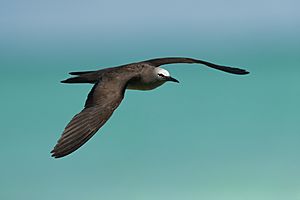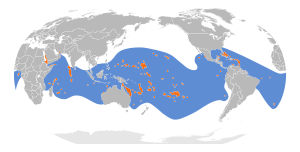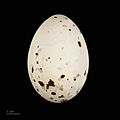Brown noddy facts for kids
Quick facts for kids Brown noddy |
|
|---|---|
 |
|
| Conservation status | |
| Scientific classification | |
| Genus: |
Anous
|
| Species: |
stolidus
|
 |
|
| Synonyms | |
|
Sterna stolida Linnaeus, 1758 |
|
The brown noddy or common noddy (Anous stolidus) is a type of seabird. It belongs to the family called Laridae, which also includes gulls and terns.
This bird is the biggest of the noddies. You can tell it apart from the black noddy because it's larger. Its feathers are dark brown, not black.
The brown noddy lives in warm, tropical parts of the world. You can find it in many places. These include Hawaii and Australia in the Pacific Ocean. It also lives from the Red Sea to the Seychelles in the Indian Ocean. In the Atlantic Ocean, it's found from the Caribbean down to Tristan da Cunha.
Brown noddies like to live in large groups, called colonies. They usually build their nests in high places. This could be on cliffs or in short trees and bushes. Sometimes, they might nest on the ground. Each breeding season, the female bird lays one egg. In India, the brown noddy is a protected bird. It lives in the PM Sayeed Marine Birds Conservation Reserve.
Contents
About the Brown Noddy's Name
The first official description of the brown noddy was made in 1758. A Swedish scientist named Carl Linnaeus gave it the scientific name Sterna stolida. Later, in 1826, an English scientist named James Francis Stephens created the group, or genus, Anous for these birds.
The name Anous comes from an Ancient Greek word. It means "stupid" or "foolish." The second part of its scientific name, stolidus, is a Latin word. It also means "stupid" or "foolish." This name might have come from how easily these birds could be caught by early sailors.
Scientists recognize four main types, or subspecies, of the brown noddy:
- A. s. pileatus: Found in the Red Sea, Indian Ocean, and across the Pacific to Hawaii and Easter Island.
- A. s. galapagensis: Lives in the Galápagos Islands.
- A. s. ridgwayi: Found on islands near western Mexico to Costa Rica.
- A. s. stolidus: Lives on islands in the Caribbean and tropical Atlantic.
What the Brown Noddy Looks Like
The brown noddy is about 38 to 45 centimeters (15 to 18 inches) long. Its wings can spread out to 75 to 86 centimeters (30 to 34 inches) wide.
Its body feathers are a dark chocolate-brown color. But its head, especially the top and front, is a pale gray or white. It has a thin, white ring around its eyes. The tail is long and shaped like a wedge. Its feet and legs are dark.
How Brown Noddies Live
Nesting and Raising Chicks
Brown noddies are social birds. They often nest together in large groups. They usually build their nests on cliffs, in trees, or in bushes. Sometimes, they might lay their eggs right on the ground. Their nest is usually a flat platform made from sticks and twigs.
When a male and female brown noddy are ready to mate, they perform special dances. They bow and nod to each other. The male bird might also catch a small fish and give it to the female. They also fly together as part of their courtship.
The female bird lays one egg. It is usually pinkish-cream with purple and brown spots. The egg is about 52 by 35 millimeters (2 by 1.4 inches) in size. Both parents take turns sitting on the egg to keep it warm. They incubate it for 33 to 36 days. Each parent sits for one or two days while the other goes to sea to find food.
After the chick hatches, it grows very quickly. It can reach the same weight as its parents in about three weeks. When the chick is ready to fly, around six to seven weeks old, it might even weigh more than its parents. However, it quickly loses this extra weight once it starts flying. At this point, the young bird starts to become more independent. It learns how to find its own food.
What Brown Noddies Eat
Brown noddies find their food by flying low over the water. They swoop down and dip their beaks into the water. This is how they catch small squid and fish to eat.
Gallery
-
Brown noddies nesting in Tubbataha Reef National Park in the Philippines.
-
This is Anous stolidus galapagensis, a type of brown noddy found only in the Galápagos Islands, Ecuador.
Images for kids
-
A. s. stolidus in São Tomé and Príncipe.
-
A. s. stolidus flying in São Tomé and Príncipe.
See also
 In Spanish: Tiñosa común para niños
In Spanish: Tiñosa común para niños










